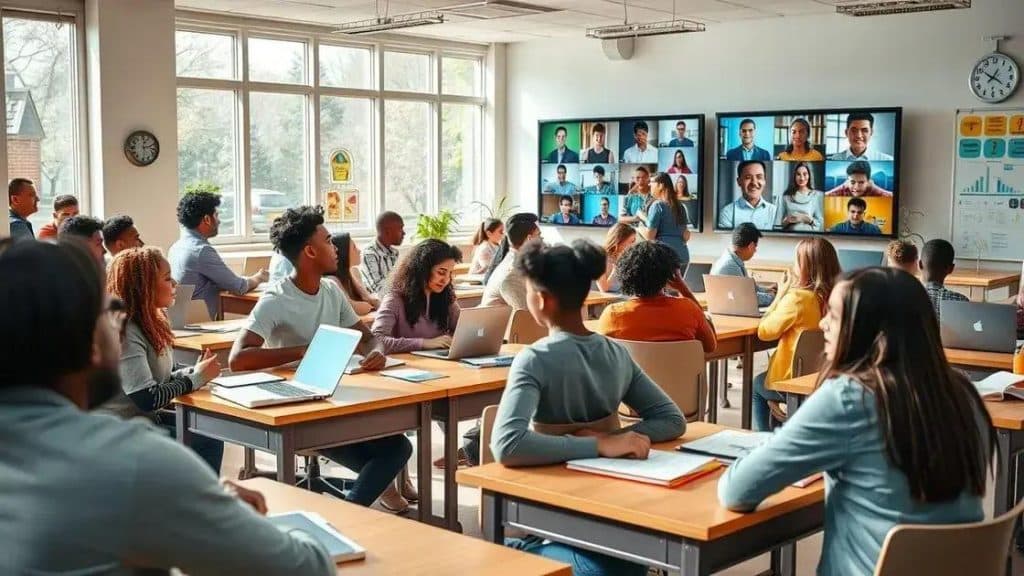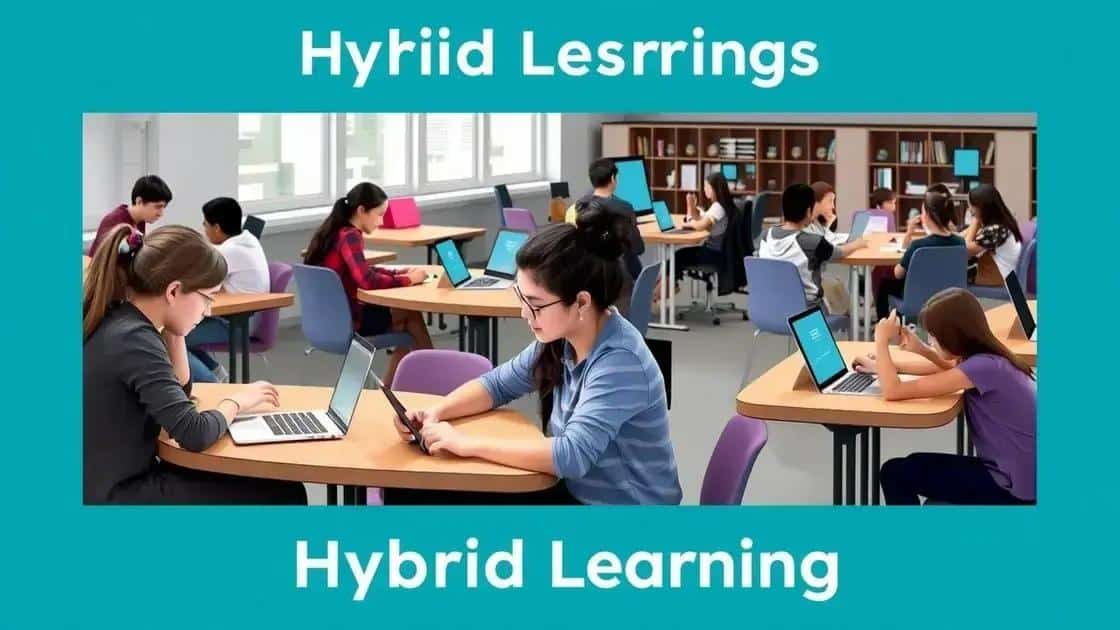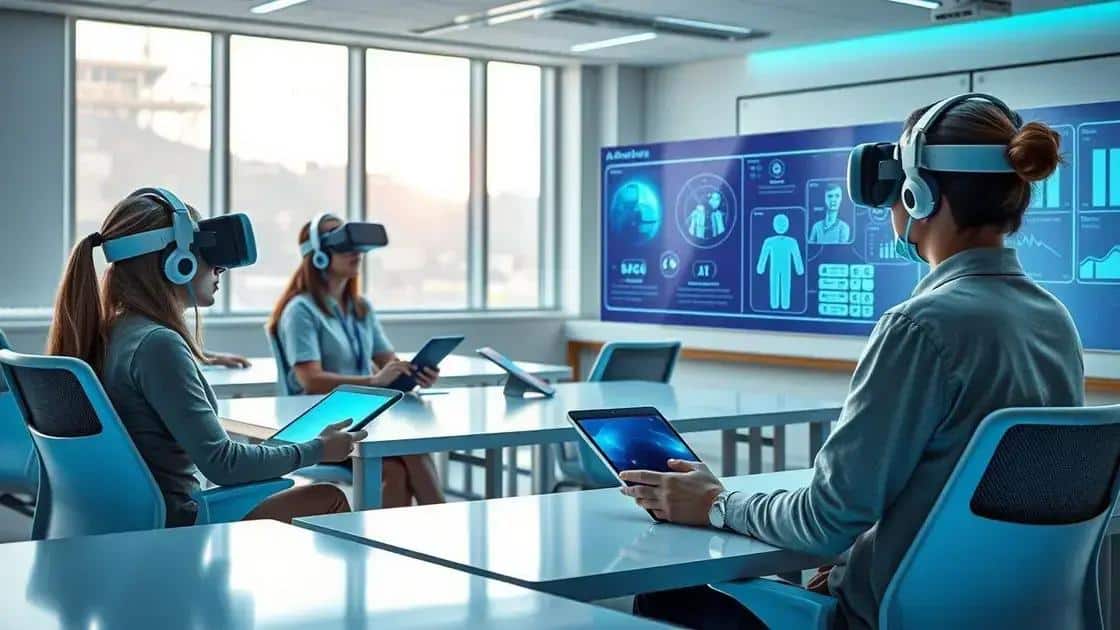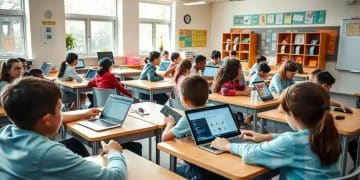What’s new in hybrid learning success: key insights

Hybrid learning success involves leveraging technology for personalized education, focusing on social-emotional learning, and using data-driven metrics to enhance engagement and outcomes in both online and in-person environments.
What’s new in hybrid learning success is a topic that continually evolves. With educational institutions adapting to new technologies, have you ever wondered how these changes impact the way we learn?
Understanding hybrid learning dynamics
Understanding hybrid learning dynamics is crucial for educators and students alike. This approach blends traditional face-to-face learning with online components, creating a versatile educational environment. By recognizing the strengths and challenges of hybrid learning, we can enhance engagement and outcomes.
Key Components of Hybrid Learning
In a hybrid model, students can benefit from various learning styles. This means adapting content delivery to fit both in-person and online interactions. Important aspects include:
- Flexibility: Students can choose where and how to learn.
- Accessibility: Resources are available anytime, ensuring learning can continue outside the classroom.
- Collaboration: Fosters teamwork among peers, both in-person and virtually.
Transitioning into this dynamic requires careful planning. Educators must design their curricula to utilize technology effectively. This involves selecting the right platforms to facilitate learning and ensuring that every student is equipped to participate fully.
Tech Tools for Successful Hybrid Learning
Incorporating technology is vital in hybrid learning. Tools like virtual classrooms and collaborative software can enrich the learning experience. These technologies allow for seamless communication, ensuring that all learners connect on the same level.
To enhance understanding, consider these tech tools:
- Video Conferencing: Platforms like Zoom or Microsoft Teams facilitate real-time discussions.
- Learning Management Systems: Systems like Google Classroom or Canvas help organize materials.
- Interactive Quizzes: Tools such as Kahoot! engage students while assessing their knowledge.
Ultimately, understanding hybrid learning dynamics involves adapting teaching methods to meet the needs of a diverse student body. Students should feel empowered to take charge of their learning, whether they are at home or in a classroom.
Key strategies for student engagement

Engaging students in a hybrid learning environment requires innovative strategies. Educators need to find ways to captivate both in-person and online learners. By utilizing a variety of techniques, they can create a supportive atmosphere that encourages participation.
Interactive Learning Activities
One effective method involves interactive activities. These activities captivate student interest while helping them connect with the material. Examples of interactive strategies include:
- Group Discussions: Encourage students to share their thoughts and ideas.
- Polling: Use instant polls to gauge understanding and collect opinions.
- Project-Based Learning: Let students work on projects that solve real-world problems.
Providing opportunities for interaction helps students feel more connected. Whether they are in the classroom or participating remotely, student engagement becomes more robust with the right tactics.
Technology Integration
Utilizing technology is essential in enhancing student engagement in hybrid learning. Tools like multimedia presentations, online quizzes, and collaborative apps can make lessons more dynamic. When integrated effectively, technology can:
- Enhance Understanding: Visual aids can clarify complex concepts.
- Personalize Learning: Technology allows students to learn at their own pace.
- Facilitate Communication: Tools foster communication between peers and instructors.
A diverse range of tech tools allows teachers to tailor their lessons to meet student needs. This adjustment keeps learners interested, ensuring that all students participate and benefit from their education.
Fostering a Positive Learning Environment
A supportive atmosphere is crucial for engaging students. Establishing trust and respect allows students to express themselves freely. Creating an inclusive environment where every voice matters fosters confidence. Teachers can implement strategies like:
- Positive Reinforcement: Highlight student achievements to encourage continued effort.
- Open Feedback Channels: Encourage students to provide feedback on the course and their experiences.
- Community Building: Organize team-building activities to strengthen peer relationships.
By focusing on student engagement, educators can ensure that learners in both physical and virtual classrooms enjoy meaningful educational experiences.
Measuring success in hybrid environments
Measuring success in hybrid environments is crucial for understanding how well educational systems perform. Both instructors and students benefit from clear performance metrics. By assessing various elements, we gain insights into what works and what needs improvement.
Key Performance Indicators (KPIs)
Utilizing Key Performance Indicators (KPIs) can help schools evaluate success in hybrid learning. These metrics provide specific, measurable outcomes that guide educators. Important KPIs include:
- Student Engagement: Track participation rates in both online and in-person activities.
- Assessment Scores: Evaluate test and assignment scores to gauge understanding.
- Attendance Rates: Monitor attendance to ensure students attend both formats regularly.
Using these indicators helps identify trends and areas for improvement. Regularly reviewing KPIs ensures that the focus remains on enhancing the learning experience.
Feedback Mechanisms
Collecting feedback from students and parents is another fundamental component of measuring success. Surveys and interviews provide valuable insights into student experiences. This feedback creates a loop for continuous improvement. Implementing structured feedback mechanisms can:
- Identify Challenges: Highlight common issues students face in hybrid learning.
- Gauge Satisfaction: Assess how satisfied students and parents are with the hybrid format.
- Inform Instruction: Use insights to refine teaching methods and materials.
By maintaining open channels for feedback, educators can make informed adjustments that resonate with students.
Data Analysis and Reporting
Analyzing collected data allows schools to make informed decisions. Regular reports on KPIs and feedback can reveal patterns in student performance. Reporting can include:
- Trends Over Time: Examine changes in engagement or performance over semesters.
- Comparative Analysis: Compare performance between online and in-person students.
- Success Stories: Highlight case studies of effective strategies.
This comprehensive analysis aids educators in adapting methods to enhance both in-person and online learning, ultimately promoting a more successful hybrid learning environment.
Future trends in hybrid education

Future trends in hybrid education are reshaping how teaching and learning occur in classrooms and online. This evolving landscape presents exciting opportunities for enhancing student engagement and learning outcomes. Educators are exploring innovative methods to combine these formats effectively.
Personalized Learning Experiences
One major trend is the move towards personalized learning. Students benefit when learning experiences are tailored to their individual needs and preferences. By implementing adaptive learning technologies, teachers can provide customized resources that appeal to various learning styles. This approach allows students to progress at their own pace, leading to better understanding and retention of information.
Increased Use of Technology
As technology continues to evolve, its role in education becomes increasingly prominent. Classrooms are integrating tools such as virtual reality (VR) and artificial intelligence (AI) to enhance learning. VR can create immersive environments where students can explore complex concepts in 3D. Similarly, AI can assist in analyzing student performance, allowing educators to adjust teaching methods based on real-time data.
- Immersive Learning: Use VR to create engaging, simulated learning experiences.
- AI-Driven Analytics: Leverage AI to identify learning patterns and personalize instruction.
- Collaborative Tools: Foster teamwork through online platforms that enhance communication.
The integration of these technologies promotes active participation and deeper learning experiences for students in hybrid settings.
Focus on Social-Emotional Learning
Another significant trend involves emphasizing social-emotional learning (SEL). As education becomes more flexible, it is important to address the emotional well-being of students. Educators are incorporating SEL in their curricula to help students manage their emotions, build positive relationships, and make responsible decisions. This focus fosters a more supportive and inclusive learning environment, essential for student success.
Programs that address SEL can:
- Enhance Resilience: Teach students coping strategies to handle challenges.
- Promote Empathy: Encourage understanding and cooperation among peers.
- Build Confidence: Help students develop a positive self-image.
By targeting the emotional components of education, schools can create a more holistic approach to student development in hybrid learning contexts.
Collaboration Between Educators and Students
Future trends also point towards a growing collaboration between educators and students. Co-creating learning experiences fosters a sense of ownership in students. Educators can involve students in decision-making processes, allowing them to suggest topics and methods that resonate with their interests.
This trend encourages active participation and empowers students to take responsibility for their learning. By embracing these future trends, hybrid education can evolve to meet the changing needs of students and educators alike.
FAQ – Frequently Asked Questions about Hybrid Education
What are the main benefits of hybrid learning?
Hybrid learning offers flexibility, allowing students to choose where and how they learn, which can lead to increased engagement and better outcomes.
How can technology enhance hybrid education?
Technology, like virtual reality and AI, can create immersive experiences, personalize learning, and provide instant feedback to support students.
What role does social-emotional learning play in hybrid education?
Social-emotional learning fosters emotional well-being, promoting resilience and empathy among students, which is essential for a positive learning environment.
How can educators measure success in hybrid learning environments?
Success can be measured using Key Performance Indicators (KPIs), such as student engagement, assessment scores, and attendance rates, along with feedback from students.





